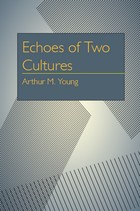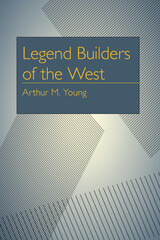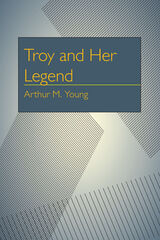3 books about Young, Arthur Milton

Echoes of Two Cultures
Arthur Milton Young
University of Pittsburgh Press, 1964
The theme of Echoes of Two Cultures is the transmission of two cultures through legend, how the ideals and moralities of ancient Greece and Rome have inspired and informed successive civilizations to the present day.
The legends of Cyrus the Great, from the early Greek world, and Lucretia, of early Rome, recount stories of transgression of rights; the first against a people, the second against an individual. The Greeks of the time of Cyrus, in the 5th century BC, believed that history taught them about an inexorable and divinely ordained law of ethics meant to punish the overweening transgressor. The citizens of Lucretia's Rome were motivated by a solemn respect for the sanctity of women and of the home. In both legends, it is an individual woman's courage and determination that brings the offender to his rightful doom, although, in the process of this retribution, both women suffer great loss.
Young shows how the telling of these great legends, which have gathered strength and beauty from each retelling, echo down through the centuries and throughout the Western World, influencing and enlightening societies and individuals.
The legends of Cyrus the Great, from the early Greek world, and Lucretia, of early Rome, recount stories of transgression of rights; the first against a people, the second against an individual. The Greeks of the time of Cyrus, in the 5th century BC, believed that history taught them about an inexorable and divinely ordained law of ethics meant to punish the overweening transgressor. The citizens of Lucretia's Rome were motivated by a solemn respect for the sanctity of women and of the home. In both legends, it is an individual woman's courage and determination that brings the offender to his rightful doom, although, in the process of this retribution, both women suffer great loss.
Young shows how the telling of these great legends, which have gathered strength and beauty from each retelling, echo down through the centuries and throughout the Western World, influencing and enlightening societies and individuals.
[more]

Legend Builders of the West
Arthur Milton Young
University of Pittsburgh Press, 1958
Classical mythology came west from Greece, bearing the thoughts, feelings, and distilled experiences of ancient peoples that have, in turn, been formed by the skilled hands of artists into tangible creations of beauty and significance. Before there were records to preserve significant events, these stories were passed down in tales and songs. Adapted and embellished by successive generations, they were later written down and used to create art from many different materials in different mediums. Within these stories and the creations they inspired was an impulse either to recover the secrets of something that had been lost or to create something new from the old material.
Young examines nine legends-Perseus and Andromeda; Demeter and Persephone; Pyramus and Thisbe; Pygmalion and Galatea; Daedalus and Icarus; Atlanta and Hippomenes; Philemon and Baucis; Echo and Narcissus; and Pomona and Vertumnus-explaining the legends themselves and tracing their dissemination through centuries and civilizations and across various art forms. In Young's view, classical mythology, through expressing humanity's enthusiasms, visions, and talents, might well be considered the “skilled midwife” of human civilization, proof of our constant effort to possess life symbolically and express it through arts.
Young examines nine legends-Perseus and Andromeda; Demeter and Persephone; Pyramus and Thisbe; Pygmalion and Galatea; Daedalus and Icarus; Atlanta and Hippomenes; Philemon and Baucis; Echo and Narcissus; and Pomona and Vertumnus-explaining the legends themselves and tracing their dissemination through centuries and civilizations and across various art forms. In Young's view, classical mythology, through expressing humanity's enthusiasms, visions, and talents, might well be considered the “skilled midwife” of human civilization, proof of our constant effort to possess life symbolically and express it through arts.
[more]

Troy and Her Legend
Arthur Milton Young
University of Pittsburgh Press, 1948
The power of legend is that it is never simply an old tale retold. Though the legend may be old, its meaning and influence is new in each retelling and for each new group of listeners.
Young provides here a “biography” of the greatest of the classical legends, the story of the fall of Troy. As he states in his book, the greatness of the legend does not depend on its relation to historical reality, but “lies rather in the beauty and variety it has called out of the creative imaginations of artists, from Homer down to modern times, artists who with varied skill and in many forms have expressed their individual genius.” Young's text is beautifully illustrated with examples of art inspired by the legend, from literature, painting, ceramics, tapestry, sculpture, and the opera, with fresh interpretations of their meaning. The legend of Troy has survived more than 3,000 years in the art of many-from Quintus of Smyrna to Tennyson to Christopher Morley, Guérin to Baroccio to Strauss-and archaeological excavations in our own time have only enriched the imaginations of contemporary artists and scholars.
In deepening our knowledge of classic texts and their changing interpretations over time, Young argues, we enhance our understanding both of the classics and of the successive civilizations they have influenced.
Young provides here a “biography” of the greatest of the classical legends, the story of the fall of Troy. As he states in his book, the greatness of the legend does not depend on its relation to historical reality, but “lies rather in the beauty and variety it has called out of the creative imaginations of artists, from Homer down to modern times, artists who with varied skill and in many forms have expressed their individual genius.” Young's text is beautifully illustrated with examples of art inspired by the legend, from literature, painting, ceramics, tapestry, sculpture, and the opera, with fresh interpretations of their meaning. The legend of Troy has survived more than 3,000 years in the art of many-from Quintus of Smyrna to Tennyson to Christopher Morley, Guérin to Baroccio to Strauss-and archaeological excavations in our own time have only enriched the imaginations of contemporary artists and scholars.
In deepening our knowledge of classic texts and their changing interpretations over time, Young argues, we enhance our understanding both of the classics and of the successive civilizations they have influenced.
[more]
READERS
Browse our collection.
PUBLISHERS
See BiblioVault's publisher services.
STUDENT SERVICES
Files for college accessibility offices.
UChicago Accessibility Resources
home | accessibility | search | about | contact us
BiblioVault ® 2001 - 2024
The University of Chicago Press









